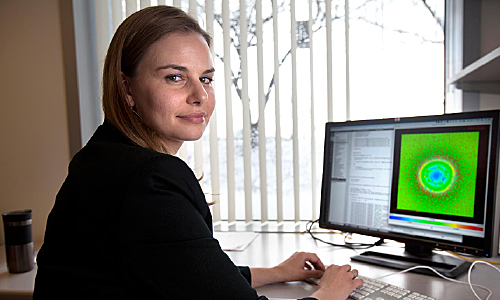
Fighting tuberculosis
The approved antibiotic regimens may be failing to eradicate tuberculosis bacteria too often. A computer model could help fight antibiotic resistance

The approved antibiotic regimens may be failing to eradicate tuberculosis bacteria too often. A computer model could help fight antibiotic resistance
In 2006, extensively drug resistant tuberculosis infected 53 people who were treated at the Church of Scotland Hospital in Tugela Ferry, South Africa. Within about a month of diagnosis, fifty-two of those patients died.
Elsje Pienaar, a native of South Africa, was just beginning her graduate work studying tuberculosis (TB) when the outbreak happened about 200 miles from her hometown of Secunda.
“Two things struck me about this outbreak. First, the frighteningly high mortality rate and fast progression of the disease, compared to ‘normal’ TB cases where the disease progresses rather slowly over time. Second, the fact that this high-level resistance to multiple different antibiotics was able to emerge when we are supposed to have a good handle on TB treatment,” she said.
“I wondered if this was a ‘man-made’ monster that we inadvertently created because we do not fully understand the complex dynamics involved in TB treatment and control.”
The World Health Organization (WHO) affirmed her suspicions, calling the outbreak a “wake-up call” about the problems in fighting tuberculosis. Because the serious lung infection requires months of antibiotic treatment to cure, it is extremely prone to developing drug resistant strains. Patients stop taking the antibiotics too early, leaving behind the strains of the bacteria that don’t die easily.
To prevent this, the WHO recommends that TB patients should receive their doses from healthcare professionals, or at least have someone designated to make sure they take their antibiotics on schedule. Even with these precautions, the WHO estimates that 480,000 people developed multi-antibiotic-resistant TB in 2014.
But non-compliant patients might not be the only problem. The study that Pienaar and her colleagues recently published in BMC Systems Biology suggests that recommended treatments don’t always fully cure tuberculosis, even when followed exactly. If the bacteria survive inside the lesions in the lungs, called granulomas, they may well be resistant strains.
A computer model of tuberculosis

Pienaar works with Jennifer Linderman, a professor of chemical engineering and biomedical engineering, and Denise Kirschner, a professor of microbiology and immunology. Together, they built a computer model of a granuloma using data collected by Véronique Dartois, a professor of medicine at Rutgers University, from experiments with rabbits. The model also relies on data from macaque monkeys, provided by JoAnne Flynn, a professor of microbiology and molecular genetics at the University of Pittsburgh.
The results of the experiments from Dartois and Flynn ground the model in real measurements. For instance, they can show how the antibiotics are distributed inside the granulomas six hours after taking a dose or how many bacteria are left alive two months into a treatment regimen. The model then uses known behaviors of cells and chemicals to fill in the gaps between the measurements.
Pienaar, Linderman and Kirschner used the model to test treatments with the standard anti-TB drugs isoniazid and rifampin. They included regimens of larger doses a few times per week and smaller daily doses, schedules approved by the U.S. Center for Disease Control. The computer simulations showed that daily treatment with both antibiotics is the best way to go, but even then, the drugs have a hard time killing off all of the TB bacteria.
Part of the problem is that the granuloma serves as a fortress of sorts for the bacteria. “The drugs actually have to penetrate into the core of this granuloma,” said Kirschner.
Even then, Kirschner says that the bacteria can protect themselves further by going into a passive state, in which they stop trying to reproduce. “If it’s just sitting there, the drug is not going to have as strong an effect on it, which is why you have to treat for six months. You need to catch those bacteria in the few moments when they divide,” she added.
Looking for a way to kill these holdouts, the team investigated whether increasing the number of doses would help raise the antibiotic concentrations inside the granulomas. They found that upping the doses to nine per week, perhaps with patients taking morning and evening doses twice per week, they were able to cut the time until the bacteria were wiped out by about ten days, on average.
They also explored what drug properties to target to make isoniazid and rifampin more effective. For instance, they found that if the cells in the body take up about 20 percent less isoniazid, allowing the drug more time to kill TB bacteria, it could drop the treatment failure rate from 1 percent to nearly 0 percent. This change could represent a hundred thousand more successful treatments per year.
New antibiotics and treatments
Next, the team wants to look beyond standard antibiotics and explore the possibilities of new drugs. Considering approved and experimental drugs together, there are trillions of potential combinations and regimens.
“Experimentalists can’t test thousands and thousands of antibiotic regimens, but we can,” said Linderman.
Studies with animals are expensive, time consuming and present ethical dilemmas. With tuberculosis, the challenges are magnified because only primates get latent TB, in which bacteria can hole up in granulomas without causing symptoms for decades.
The computational and experimental team aims to speed up the development of new drugs and treatments. The National Institutes of Health have just awarded them a grant to build new antibiotics into their computer model and explore different regimens.
A paper on this research is published in the journal BMC Systems Biology, titled “In silico evaluation and exploration of antibiotic tuberculosis treatment regimens.”
This work was supported by the National Institutes of Health, with computing resources provided by the National Energy Research Computing Center, the Open Science Grid and the Extreme Science and Engineering Discovery Environment.